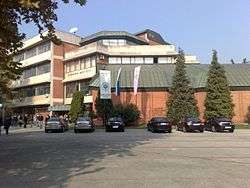University of Kragujevac Faculty of Technical Sciences
The Faculty of Technical Sciences[a] (abbr. FTN; Serbian: Факултет техничких наука Универзитета у Крагујевцу, romanized: Fakultet tehničkih nauka Univerziteta u Kragujevcu) in Čačak is an independent department of the University of Kragujevac. The school’s programs cover Basic Electrical Engineering, Computer engineering, Mechatronics, Information Technology, Informatics and Management.
Факултет техничких наука Универзитета у Крагујевцу | |
 Faculty of Technical Sciences Building | |
Former names | Pedagogical-Technical Faculty (1975–1986) Technical Faculty (1986–2012) |
|---|---|
| Type | Public |
| Established | 18 November 1975 |
| Dean | Danijela Milošević |
Academic staff | 82 (2016)[1] |
Administrative staff | 36 (2016–17)[1] |
| Students | 987 (2018–19)[2] |
| Undergraduates | 870 (2018–19)[2] |
| Postgraduates | 83 (2018–19)[2] |
| 34 (2018–19)[2] | |
| Location | Svetog Save 65, Čačak , 43.897088°N 20.344824°E |
| Campus | Urban |
| Affiliations | University of Kragujevac |
| Website | www |
 | |
Founded in 1975, the school nowadays offers academic and undergraduate studies, master degree studies, doctoral and specialist undergraduate studies.
History
The institution was established as Pedagogical-Technical Faculty with the assignment of developing teachers of mechanical and electrical engineering, and technical education.
The Faculty was founded on 8 November 1975. In 1982, the Faculty extended the field of its activity by the admission of graduates to BSc in Mechanical and Electrical engineering. Since 1986, the Faculty has been operating under the name of Technical Faculty, and has pursued its work under the name ever since. The studies that were held at the Faculty were: Electrical Engineering (Industrial Energetics), Electrical Engineering (Power Systems), Mechanical Engineering, Electrical and Technical Education. In 1998, the Post-Secondary School of Technical Education dissociated from the Faculty.
Because of the significance of computing and informatics in the modern world, and their close relation to other technical fields, new teaching groups were introduced into the teaching program of the Technical Faculty in academic year 1992–93. The studies leading to the following degrees were introduced: Electrical Engineering (Mechatronics) and Technics and Informatics. This was particularly justified in the academic year 1998-99 by introduction of the Section that gave graduate students with the title of: BS'c in Computer Engineering and BA in Industrial Management were introduced.
On 15 October 2012, the faculty officially changed its name to Faculty of Technical Sciences. The name changing was followed by a significant increase in the activities of this higher education institution as well as expanding the spectrum in the field of scientific research.[3]
To the present day, the faculty has accomplished significant results in the field of education, which has been its principal activity. In its 40-year old existence, around 3,200 students have graduated from the Faculty.
Departments
The Faculty has the following Departments/Institutes for:
- Department of Computer Engineering
- Department of Electrical Engineering
- Department of Entrepreneurship Management
- Department of Industrial Engineering
- Department of Industrial Management
- Department of Information Technologies
- Department of Mechanical Engineering
- Department of Mechatronics
- Department of Physics and materials
- Department of Power Engineering
- Department of Technical and Pedagogy Education
See also
References
- "ИНФОРМАТОР О РАДУ ФАКУЛТЕТА ТЕХНИЧКИХ НАУКА У ЧАЧКУ" (PDF). ftn.kg.ac.rs (in Serbian). gg. Retrieved 27 December 2017.
- "Високо образовање 2018/2019" (PDF). stat.gov.rs (in Serbian). Statistical Office of Serbia. Retrieved 22 December 2019.
- "Технички факултет у Чачку променио назив у ФАКУЛТЕТ ТЕХНИЧКИХ НАУКА". tfc.kg.ac.rs. Retrieved 10 November 2012.
| a. | ^ The word Faculty in Europe stands for an academic institution, the sub-unit inside the University. |
External links
| Wikimedia Commons has media related to University of Kragujevac Faculty of Technical Sciences. |

